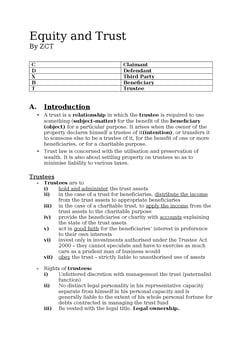McCormick v Grogan [1869] LR 4 HL 82
Judgement for the case McCormick v Grogan
Table Of Contents
KEY POINTS
A will and a trust are legal instruments designed to address the distribution of assets and the management of an individual's estate, but they serve different purposes.
A will is a crucial document that outlines an individual's wishes regarding the distribution of their assets after their death. It typically appoints an executor responsible for carrying out the instructions specified in the will. Wills are essential for individuals seeking clarity and direction for their heirs, ensuring their property is distributed according to their preferences.
On the other hand, a trust is a legal entity that holds and manages assets on behalf of beneficiaries. Unlike a will, a trust can be effective both during the individual's lifetime and after death. Trusts offer greater flexibility and privacy than wills, allowing individuals to specify detailed instructions for asset distribution, potentially avoiding the probate process and associated costs.
FACTS
C. executed a will in which he bequeathed his entire estate, comprising real and personal property, to G.
C. appointed G. as the executor of the will. As C. neared the end of his life, he summoned G. for a private meeting and disclosed the details of the will. During this conversation, when questioned by G., C. affirmed that the will accurately reflected his wishes, expressing a desire for no alterations.
C. provided G. with information about the location of the will and mentioned the existence of a letter accompanying it. The letter listed numerous individuals to whom C. wished to distribute sums of money and annuities. However, the letter included language granting G. discretionary authority, stating that he should carry out the testator's intentions "as he might think best."
The letter contained a clause emphasizing that G. was not obligated to adhere to the instructions strictly and urged him to use his judgment to execute the bequests. The letter explicitly instructed G. not to disclose the existence of the document.
G. was responsible for disbursing funds to some individuals identified in the letter but not all. This factual account presents the circumstances surrounding C.'s will, the private instructions conveyed to G., and the discretionary powers granted to G. in fulfilling the testator's intentions.
JUDGEMENT
The court determined that, in that particular case, no legally binding trust was established with respect to G. The circumstances surrounding the execution of the will and the accompanying letter did not give rise to an enforceable trust obligation on G.'s part.
Despite the detailed instructions provided in the letter regarding the distribution of assets and the discretionary powers granted to G., the court concluded that these elements did not constitute the formation of a trust that would legally bind G.
As a result, G. was not held to the strict terms outlined in the letter, and no enforceable trust relationship existed in that matter.
COMMENTARY
This case involves a will where the Testator, C., clearly bequeaths their entire estate to G. and appoints G. as the Executor. A pivotal private meeting between C. and G. reinforces the gravity of the situation, with C. expressing a strong desire for the unaltered execution of the will.
The complexity increases with the introduction of a letter accompanying the will. While detailing beneficiaries and financial allocations, the letter grants G. discretionary authority to fulfill the Testator's intentions. Despite the explicit instructions, the court determined that no legally binding trust was established, highlighting the intricacies of trust law and the importance of meeting specific legal criteria for recognition.
In essence, this case serves as a reminder of the legal complexities surrounding wills and trusts. It underscores the need for precision in legal documents and adherence to specific criteria for creating legally binding relationships. The court's ruling reflects a careful analysis, emphasizing that legal formalities must be met for a trust to be recognized and enforced.
ORIGINAL ANALYSIS
S left his entire estate to T in his will, whom he later gave an envelope stating that the letter enclosed gave T instructions for distributing the property. The letter gave the names of S’ relatives / friends but left it “to T’s good judgment” to distribute the estate in a way that S himself would have.
A disappointed beneficiary, who didn’t get anything, argued that there was a secret trusts and that T was in breach of it.
HL found that there was no secret trust: Secret trusts are only justified in skirting round the Wills Act when there was evidence that a fraud had occurred or was likely to occur, on the basis that equity won’t allow a statute to be used as an instrument of fraud.
Here, there was no such evidence and therefore no secret trust was imposed. It was held that S did not intend to impose an obligation on T.
Fully secret cannot possibly be inter-vivos express trusts because a declaration of trust has not been made and they would therefore be void under s.53 LPA 1925. Rather they can only be explained as constructive trusts - see the Oakley pages.
For Further Study on McCormick v Grogan
Need instant answers? Our AI exam tutor is here to help.
Ask questions 🙋 Get answers 📔 It's simple 👁️👄👁️
Our AI is educated by the highest scoring students across all subjects and schools. Join hundreds of your peers today.
Get StartedRelated Product Samples
These product samples contain the same concepts we cover in this case.
| Trusts and Equity | Trust Formalities Notes (19 pages) |

 Since 2010, Oxbridge Notes has been a trusted education marketplace, supplying high-quality materials from top achievers at universities like Oxford, Cambridge, LSE, Harvard, and Yale.
Since 2010, Oxbridge Notes has been a trusted education marketplace, supplying high-quality materials from top achievers at universities like Oxford, Cambridge, LSE, Harvard, and Yale.